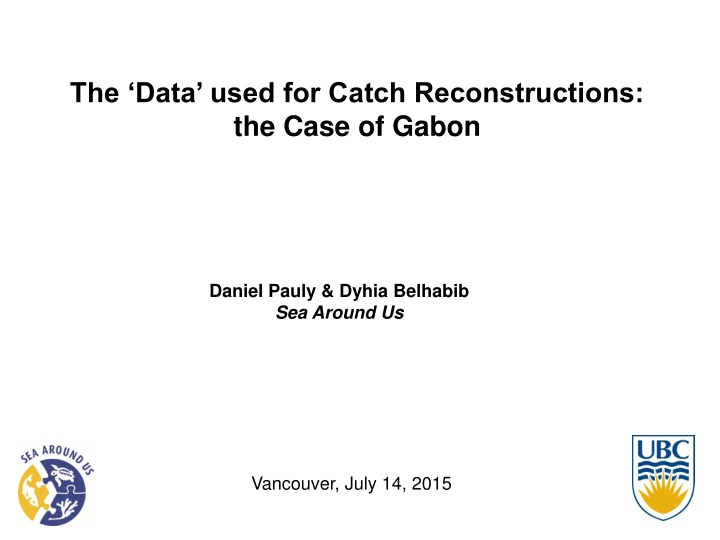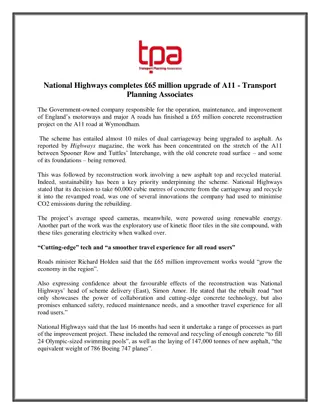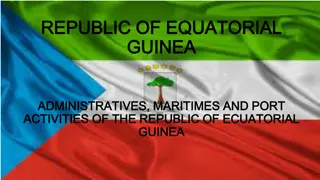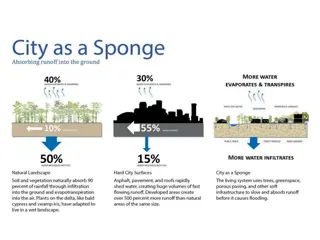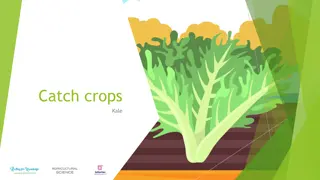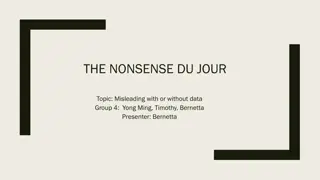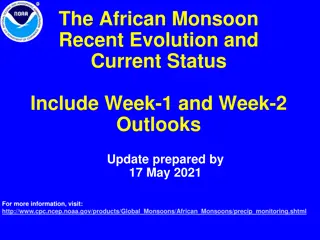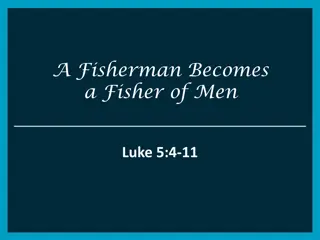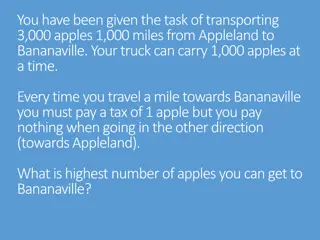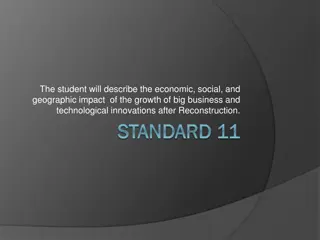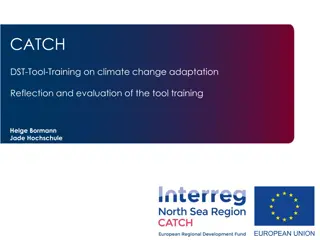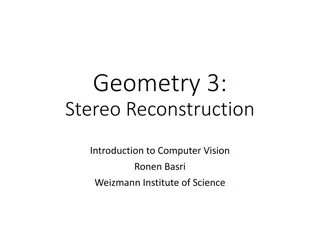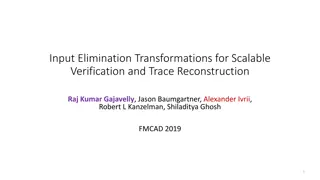Catch Reconstruction in Gabon: Addressing Misleading Questions
Exploring catch reconstructions in Gabon, this study by Daniel Pauly and Dyhia Belhabib highlights the importance of accurate data. Nature's question becomes a starting point for discussing the complexities of fisheries management and sustainability.
Download Presentation

Please find below an Image/Link to download the presentation.
The content on the website is provided AS IS for your information and personal use only. It may not be sold, licensed, or shared on other websites without obtaining consent from the author.If you encounter any issues during the download, it is possible that the publisher has removed the file from their server.
You are allowed to download the files provided on this website for personal or commercial use, subject to the condition that they are used lawfully. All files are the property of their respective owners.
The content on the website is provided AS IS for your information and personal use only. It may not be sold, licensed, or shared on other websites without obtaining consent from the author.
E N D
Presentation Transcript
The Data used for Catch Reconstructions: the Case of Gabon Daniel Pauly & Dyhia Belhabib Sea Around Us Vancouver, July 14, 2015
We can start considering reconstruction here, when Nature asked a misleading question:
As posed by Nature, this question is misleading because even if the answer were negative, we still require catch data when working on fisheries, because: 1.The size of a fishery, relevant to assessing whether, e.g., it warrants devoting resources to its study and management; 2.The gross value of a fishery (when landings are multiplied with ex-vessel prices), as required, e.g., for negotiations about bilateral fisheries access agreement; 3.The magnitude of the environmental impacts of fisheries (especially when combined with the catch rate of various habitat impacting gear); and 4.The extent of criminal and/or fraudulent activities in the case ..of illegal catches, etc.
Indeed, one could argue that we dont know a fishery when we don t know its catch since it is conducted, after all, to produce a catch. Which is where accurate statistics come in... When working on the fisheries of their country, fisheries scientists, staff of environmental NGO s and other parties, usually work with their own, and/or national data, and there are few problems of accuracy. When working on foreign countries, most actors use FAO statistics, which are based on annual submissions by their iiiiiii member countries.
The FAO statistics are misleading. People think that they were roughly correct, i.e., that their errors are more or less randomly distributed (except for the famous case of China). This was wrong: the FAO data (with a few exceptions) are strongly biased downward because the countries do not see it fit to report on all of their fisheries, especially on their small-scale fisheries, which turn out to be the main source of IUU catches (i.e., unreported).
But how can we know what FAO and/or its member countries don t? (Or more accurately: don t bother with.) This is where catch reconstruction comes in, which are based on two pillars: 1) Fishing is a social activity, which therefore throws a shadow on the economy and the society that it is embedded in. Thus, in literate societies, it is not possible to operate a fishery which will leave no written trace on other sectors of the economy and/or on society at large ; and 2) Almost any reasonable estimate, even a guess based on this societal shadow in (1) will be a better than the estimate of zero that is implied when, absent detailed statistics, a iiiiiiiiiii bureaucrat simply ignores a fishery.
These two points were first made in a 1998 newsletter article.
Thus, what are catch reconstructions? Catch reconstructions are estimates of all withdrawals from the ecosystem, based on: Baseline catches to 1950 (to be able to compare present with earlier system state); All sectors: industrial, artisanal, subsistence, recreational, discards (because the fish don t care who killed them); National or other information complementing the data submitted to FAO or other international bodies.
Our definitions Industrial sector: consisting of relatively large motorized vessels, requiring large sums for their construction, maintenance and operation, either domestically, in the waters of other countries and/or the high seas, and landing a catch that is overwhelmingly sold commercially; Artisanal sector: consisting of small-scale (hand lines, gillnets etc.) and fixed gears (weirs, traps, etc.) whose catch is predominantly sold commercially (notwithstanding a small fraction of this catch being consumed or given away by the crew); Subsistence sector: consisting of fisheries that often are conducted by women for consumption by one s family. Also the fraction of the catch of mainly artisanal boats that is given away to the crews families or the local community; Recreational sector: consisting offisheries conducted mainly for pleasure, although a fraction of the catch may end up being sold or consumed by the recreational fishers and their families and friends. Also: Catch = Landings + Discards
Reconstruction approach 1. Review reported catch times series National and FAO data include artisanal and industrial landings 2. Identify missing data ; Part of artisanal and industrial sectors, all of subsistence, discards 3. Alternative data sources literature searches & local experts 4. Data anchor points country-wide estimates 5. Interpolate and (cautiously) extrapolate 6. Total catch = reported + missing components 7. Assessing the uncertainty of the results.
Conceptual representation of the stepwise catch reconstruction approach as developed by members of the Sea Around Us.
Three Layers of Data Note also that we define 3 data layers : 1)Layer 1, consisting on domestic fisheries (within one s EEZ), and making the bulk of the reconstructed data; 2)Layer 2, i.e., the catch taken by industrial fisheries outside of the EEZ of their countries of origin; 3)Layer 3, the catch of industrially caught tuna and other large pelagic fishes and reported to RFMOs.
The reconstruction are done by Exclusive Economic Zones (EEZs; except for industrially-caught tuna). Extent and delimitation of countries EEZs, as claimed by individual countries, or as defined by the Sea Around Us, are based on the fundamental principles outlined in UNCLOS (i.e., 200 nautical miles or mid-line rules), and the FAO statistical areas by which global catch statistics are reported. .
Digression: the problems with EEZs Cyprus (North and South) was and remains divided
Another EEZ issue Since 1950, Crimea belonged to Russia, then Ukraine, then Russia. To which country it belongs today is very much in the eyes of the beholder .
Or Morocco 1) One view: Morocco (Mediterranean & Atlantic) + the Western Sahara; 2) Another view (preferred by our collaborators): Morocco North, Central and South.
EEZ vs. FAO areas South Africa: One EEZ in two different FAO areas. Thus, two reconstructions were done, so that our spatial products can overlap with FAO s. End of digression
Graphical representation of the 7 steps involved in catch reconstruction, as developed by members of the Sea Around Us.
The Example for this Presentation - Gabon is located in west central Africa in FAO area 34; - Gabon obtained independence in 1960; - It is a peaceful country with a prosperous economy; - Its fisheries are well developed through industrial joint ventures and a strong presence of artisanal migrant fishers. Now Dyhia takes over
Gabons industrial sector Industrial sector mainly operated by joint ventures (foreign vessels under disguise in Gabon); They are referred to as domestic ; Only part of landings are reported as vessels often land elsewhere. Ekouala 2013
Domestic industrial sector Industrial sector mainly operated by joint ventures (foreign vessels under disguise in Gabon); They are referred to as domestic ; Only part of landings are reported as vessels often land elsewhere. Kebe et al. 1996
Domestic Industrial Sector We reconstructed domestic catches then filtered out those under Chinese ownership; Catches = number of boats x CPUE.
Domestic industrial sector Number of boats 45 40 35 nu;ber of industrial vessels 30 25 20 15 10 5 0 1950 1960 1970 1980 1990 2000 2010 Year
Domestic industrial sector Number of boats 45 40 35 nu;ber of industrial vessels 30 25 20 15 Lagoin and Salmon (1970) 10 5 0 1950 1960 1970 1980 1990 2000 2010 Year
Domestic industrial sector Number of boats 45 40 35 nu;ber of industrial vessels 30 25 20 Everett (1976) 15 10 5 0 1950 1960 1970 1980 1990 2000 2010 Year
Domestic industrial sector Number of boats 45 40 35 nu;ber of industrial vessels 30 25 20 15 10 5 0 1950 1960 1970 1980 1990 2000 2010 Year Ekouala 2013
Domestic industrial sector Number of boats 45 40 35 nu;ber of industrial vessels 30 25 20 15 10 5 0 1950 1960 1970 1980 1990 2000 2010 Year Anon. 2011
Domestic industrial sector Number of boats 45 40 35 nu;ber of industrial vessels 30 25 20 Catch was given for 1956 and 1957, it was assumed constant during 1950-1956 15 10 5 0 1950 1960 1970 1980 1990 2000 2010 Year
Domestic industrial sector Number of boats 45 40 35 nu;ber of industrial vessels 30 25 20 15 10 Catch = CPUE x effort 5 0 1950 1960 1970 1980 1990 2000 2010 Year
Domestic industrial sector Number of boats 45 40 35 nu;ber of industrial vessels 30 25 20 15 10 5 0 1950 1960 1970 1980 1990 2000 2010 Year
Domestic industrial sector Catch Per Unit of Effort: For shrimp trawlers: daily landings at Libreville of 300 kg/boat for 1995 Kebe et al. 1996
Domestic industrial sector Catch Per Unit of Effort: For shrimp trawlers - Daily landings at Libreville of 300 kg/boat for 1995 - Catches are 5 to 10 times higher as only target species are reported, i.e. 7.5. Ekouala 2013
Domestic industrial sector Catch Per Unit of Effort For shrimp trawlers - CPUE = 300 x 7.5 = 2,250 kg/day - Duration of a shrimp fishing licence is 320 days - CPUE = 720 t/boat/year
Domestic industrial sector Catch Per Unit of Effort: For demersal trawlers - Daily landings at Libreville of 1,600 kg/boat for 1995 Kebe et al. 1996
Domestic industrial sector Catch Per Unit of Effort For demersal trawlers - Daily landings at Libreville of 1,600 kg/boat for 1995 for 360 days - Catches are assumed 3.25 times higher as trawlers generate lower bycatch. - CPUE = 1,872 t/boat/year
Domestic industrial sector Catch Per Unit of Effort Average CPUE is 1,296 t/boat/year
Domestic industrial sector Catch Per Unit of Effort Average CPUE is 1,296 t/boat/year The CPUE has declined because of overexploitation Ekouala 2013
Domestic industrial sector Catch Per Unit of Effort Average CPUE is 1,296 t/boat/year The CPUE has declined because of overexploitation 2500 2000 CPUE t per boat 1500 1000 500 0 1950 1960 1970 1980 1990 2000 2010 Year
Domestic industrial sector Catch Per Unit of Effort Average CPUE is 1,296 t/boat/year The CPUE has declined because of overexploitation 2500 50% of the 1996 CPUE 10% of the 1996 CPUE 2000 CPUE t per boat 1500 1000 500 0 1950 1960 1970 1980 1990 2000 2010 Year
Domestic industrial sector Catch Per Unit of Effort Average CPUE is 1,296 t/boat/year The CPUE has declined because of overexploitation
Domestic industrial sector China started fishing here 60 50 40 CPUE t x 103 30 Reliable 20 10 0 1950 1960 1970 1980 Year 1990 2000 2010
Domestic industrial sector China started fishing here 60 50 40 CPUE t x 103 30 Reliable 20 10 0 1950 1960 1970 1980 Year 1990 2000 2010
Domestic industrial sector Correction process goes through the allocation of the catch to its beneficial owner; Domestic catches are deemed those reconstructed for 1950-1955, 1958-1967 and those reported by the literature (1956, 1957, 1985-2010); Domestic catches were interpolated between 1967 and 1985; The difference between total reconstructed catches and domestic catches represents catches under joint ventures.
Domestic industrial sector 16 14 12 Catch t x 103 10 Lagoin and Salmon 1970 8 6 4 2 - 1950 1960 1970 1980 Year 1990 2000 2010
Domestic industrial sector 16 14 Haakonson 1991 12 Catch t x 103 10 Ekouala 2013 8 6 4 2 - 1950 1960 1970 1980 Year 1990 2000 2010 Houston and Barret 2014 Kebe 2011
Domestic industrial sector 16 14 12 Catch t x 103 10 8 6 4 2 - 1950 1960 1970 1980 Year 1990 2000 2010
Domestic industrial sector Domestic 60 Removed 50 40 Catch t x 103 30 20 10 China 0 1950 1960 1970 1980 Year 1990 2000 2010
